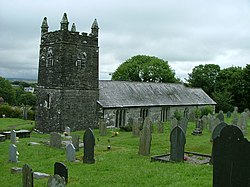Warbstow
| Warbstow | |
| Cornwall | |
|---|---|
 St Werburgh's Church, Warbstow | |
| Location | |
| Grid reference: | SX205904 |
| Location: | 50°41’6"N, 4°32’31"W |
| Data | |
| Population: | 520 (2011) |
| Post town: | Launceston |
| Postcode: | PL15 |
| Dialling code: | 01566 |
| Local Government | |
| Council: | Cornwall |
| Parliamentary constituency: |
North Cornwall |
Warbstow is a village in Cornwall, a modest place with a parish population of 520 according to the 2011 census.
The village is in a large ecclesiastical parish, 'Jacobstow with Warbstow and Treneglos', which runs up to the Devonshire border at Canworthy Water, on the River Ottery. There is a Warbstow civil parish too, which is oddly snipped into two parts, separated form each other by about 150 yards.
Both the neighbouring parish of Treneglos and Warbstow belonged in the 12th century to the Lords of Cardinham who donated them to the priory of Tywardreath. Warbstow was then a chapelry to Treneglos and the two benefices were later united as a vicarage. According to Charles Henderson, writing in 1925, "The presence ... of St Werburga ... is not easily accounted for (though the parish is famous for geese which figure in her legend)".[1]
At Youlstone an Iron Age bronze bowl was discovered in 1925.[2][3]
Churches
The parish church of St Werburgh was originally Norman, but largely rebuilt in the 15th century.
Warbstow Bury, a large Iron Age hill fort with massive ramparts. It was once the venue for an annual gathering of Methodists from the circuits of Camelford, Holsworthy (Devon) and Launceston who assembled here on Whit Tuesday for an open air service.[4]
Outside links
| ("Wikimedia Commons" has material about Warbstow) |
References
- ↑ Cornish Church Guide (1925) Truro: Blackford; p. 215
- ↑ Hencken, H. O'N. (1932) The Archaeology of Cornwall and Scilly. London: Methuen; pp. 111-12, 309; citing Antiquaries' Journal; vol. 6, p. 280
- ↑ Higher Youlton is shown on modern Ordnance Survey maps as Higher Youlston, but Lower Youlton as Youlstone. The historic form is "Youlton" as recorded in the Tithe Apportionment of 1840 and is still the name used by the farms here.
- ↑ Shaw, Thomas (1967) A History of Cornish Methodism. Truro: Bradford Barton; p. 48